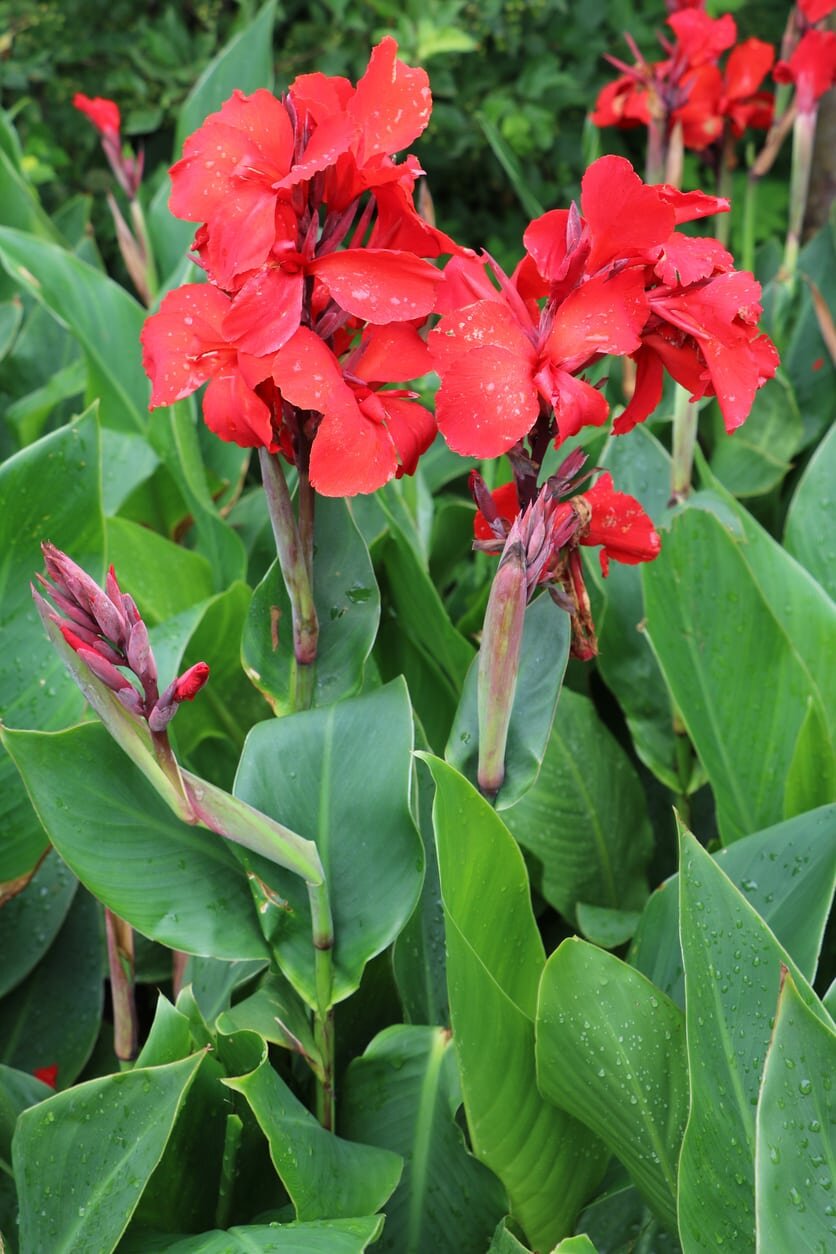Canna or Canna Lily (genus Canna)
Canna or Canna Lily (genus Canna)
Monthly Theme: You too CAN grow CANNA Lilies!
First, calling all Ohio gardeners to shout out and take a bow to our warm spring and summer gardening months! It’s that time of year that we long for and wait for throughout the cooler months of the year.
Anyone who knows me knows that I’ve grown Canna Lilies for over 20-years. My plants originally came from my Great Aunt Angie’s home in sunny Florida. She gave starter rhizomes to my mom who faithfully planted them for years and years. Mom gifted me some rhizomes and I have carried on the tradition. Since they are a tropical plant, they can’t survive our harsh Ohio winters. So, they have to be dug up and replanted yearly. I won’t lie – it’s a lot of work, but their beauty and grace are worth the effort. I believe the variety I grow are called Mr. President.
I live in a corner house and maintain the center strip in the middle of the entrance way to my neighborhood. Annually, I plant Red Canna around my yard, in containers, and in the island in the middle of the road. After I’m done planting, I sell the extra rhizomes in my front yard to neighbors and bypassers (or give them away). I’ve had people stop and say, “You’re the lady who is always working outside!” That’s me and I’m proud of the reputation.
The Canna Lily is a tropical beauty with large, broad, flat, alternate leaves that grow out of a long-rolled stem that unfurls. The leaves are typically solid emerald green, but some varieties are brownish, maroon, or variegated. The flowers are asymmetric and composed of three sepals and petals hidden under elegant stamens. The flowers are usually red, orange or yellow. Mine are red. Sadly, I’ve tried other colors without much success.
Cannas can be planted outdoors after the last frost or in containers. If you choose to plant them in containers, make sure you have good soil, drainage, water daily, and don’t allow them to become root bound. If you want to start them early indoors, plant them in late March and transplant them once the danger of frost has passed. Otherwise, just plant them directly in the ground 1-2’ apart and not too deep. The canna rhizomes [ˈrīˌzōms] are planted horizontally with the eyes (like potato eyes) facing up. Cover the rhizomes with approximately 2-3” of soil, water well, and add a layer of mulch. Like most plants they thrive in rich organic matter.
They are low maintenance and easy to grow. Both the flowers and foliage bring color, interest, and drama to your landscape. You don’t have to deadhead the spent flowers, but I like to in order to keep a clean garden. Apply a slow-release fertilizer with high phosphate contents monthly to keep them blooming.
After the first fall frost, dig up the rhizomes and store the canna lily rhizomes in a dry, cool place. Don’t cut them down or remove leaves until they have turned brown/yellow from a hard frost. I cut off the extra roots, brush off all the dirt, allow them to dry then store in open-ended boxes so they don’t mold. This procedure is called winterization. They are prolific growers, so you’ll have extra rhizomes to sell or give away. I’ve tried to store them in an unheated garage, but they rotted over the winter. Like a grizzly bear, the rhizomes will rest in the winter and be ready to thrive in the spring.
Smarty Plants Fun Facts
Canna belong to the family Cannaceae.
Some like it hot! Cannas like it hot and sunny (6 to 8 hours).
Grow 30-48” tall (At my old house, I had them grow as tall as me and I’m almost 6’ tall!) and 18-24” wide.
Bloom summer through fall
Attract butterflies and hummingbirds; deer resistant
Can be successfully grown in containers.
The President Canna
The More You Grow
In the early 1500’s one variety of Cannas came to Europe from the East Indies. In the 1800’s other species were introduced to Europe from North and South America, ranging from Argentina to the Carolinas and even parts of the Caribbean islands. Needless to say, they’ve been around the block a few times!
The Latin word Canna means cane or reed. Cannas grow from underground rhizomes (similar to bulbs), which store starch called achira. Of all known plant life, Cannas have the largest starch grains and the starchy root is edible. In Vietnam, they make cellophane” noodles from the starch. In Thailand, the canna lily is a traditional Father’s Day gift.
Though called Canna Lilies, they are not really a lily. Actually, the flower looks more like an iris. Genetically their closet plant relatives are bananas, ginger, and birds of paradise. Other common names for Canna include Indian Shot and Achira.
Since Canna Lilies grow to great heights, they make an excellent natural privacy screen. The red canna lily flowers are best for attracting hummingbirds. After they are done flowering, they produce clusters of black seeds. The birds are attracted to these seeds. Therefore, leave them on the plant if you want to attract birds to your yard.
PESTS: Japanese beetles will feed on the foliage so you’ll need to knock them off into a mason jar filled with sudsy water. If you are comfortable with insecticides, you can stray them to ward off the Japanese beetles. I pick them off in the mornings or at dusk. Also, watch out for the canna leaf roller another pest that might bother your plants.
The hybridized dwarf cannas have become more and more popular. Since they only grow 2-3’, they fit better in smaller yards. Also, the new flower colors are brighter and even more beautiful than the older varieties. However, the dwarf cannas are heavy feeders with massive root systems so you will need to be diligent about fertilizing on a regular basis. These dwarf varieties work better in containers than their taller relatives.
In conclusion, if you are looking to bring a little tropical flair to your Northeastern Ohio garden, plant cannas in your yard. Hopefully, after reading about this unique plant, you will realize that you too CAN grow CANNA! That is, of course, if you CANNA dig up the rhizomes.
“Normality is a paved road: It’s comfortable to walk, but no flowers grow.” Vincent van Gogh


